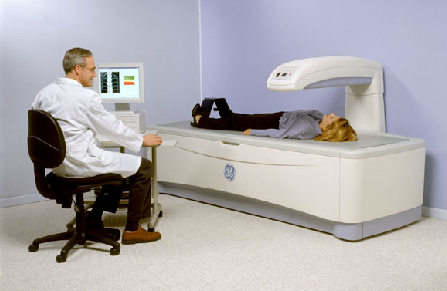Osteoporosis
What is osteoporosis?
The term osteoporosis comes from the Greek and means literally translated (osteon = bones; poros = hole). It designates a metabolic disorder of the bones, which, over time, leads to a loss of bone mass, structure and function. An especially high risk is found in women in menopause.
When a woman reaches menopause, the female sexual hormone estrogen in the blood declines. Due to this estrogen deficiency, the interaction of bone-reducing cells (osteoclast) and bone-developing cells (osteoblasts) results in an imbalance. The osteoblasts, or bone-reducing cells, increase, and the osteoclast cells are unable to compensate and thereby maintain the proper balance. Consequently, the bones become thin and brittle, and the resulting skeletal structure is termed osteopathic.
Even with relatively slight physical exertion, this can lead to broken bones in the spine, neck, wrist, etc.
As a result of such bone fractures, one can experience a greatly reduced quality of life. Spinal osteopathy, the most frequent occurrence of osteoporosis, is accompanied by characteristic physical distortions: the back bone evidences a pronounced curvature, body mass declines, skin in the area of the back reveals excessive folds, and the hands extend almost to the knees.
Of major importance in this regard is early recognition and prevention. Today osteoporosis is a disease which is diagnosable early on and can be easily treated. Aside from treatment with medications, these problems can be avoided by early diagnosis and by taking certain measures, such as taking adequate supplements of vitamin D and calcium, maintaining a healthy lifestyle, ensuring nutrition focused on bone health, and proper physical activity.
The only possibility of an early diagnosis of osteoporosis before the appearance of fractures, is the measurement of the bone mineral density with DXA technology, as recommended in the guidelines of the umbrella organization of osteopaths (DVO). This is the only recognized scientific method. Ultrasound examinations are not recommended. The bone density is measured at the skeleton axial (vertebrae of the lower spinal column) and the hips, if necessary also at the underarm.
This testing is carried out at the Radiological Institute Drs. Seybold-Epting, Leppert, Rygula, Bazak.
Karl-Marx.Str.1 , 67655 Kaiserslauter tel.: 0631 / 840940 www.radiologie-kl.de..

DXA- testing
The Orthopedic Society for Osteoporosis has provided a scientific risk profile for those at high risk of osteoporosis. If you are over 50 years of age and answer this questionnaire, you can determine whether or not you have a high risk for osteoporosis. Please click on: Osteoporosefragebogen for the questionnaire
Further information about osteoporosis can be found on the internet at
www.osteoporose-pfalz.de
What does a measurement cost?
The costs will not be assumed by the compulsory health insurances as a preventive measure. A DXA-osteoporosis measurement costs 50 euros according to the federal regulation for physicians’ fees (GOÄ). With the private insurance companies a full reimbursement is given.
If you are interested in a DXA-measurement, please contact us.
For further questions we are at your service.
The term osteoporosis comes from the Greek and means literally translated (osteon = bones; poros = hole). It designates a metabolic disorder of the bones, which, over time, leads to a loss of bone mass, structure and function. An especially high risk is found in women in menopause.
When a woman reaches menopause, the female sexual hormone estrogen in the blood declines. Due to this estrogen deficiency, the interaction of bone-reducing cells (osteoclast) and bone-developing cells (osteoblasts) results in an imbalance. The osteoblasts, or bone-reducing cells, increase, and the osteoclast cells are unable to compensate and thereby maintain the proper balance. Consequently, the bones become thin and brittle, and the resulting skeletal structure is termed osteopathic.
Even with relatively slight physical exertion, this can lead to broken bones in the spine, neck, wrist, etc.
As a result of such bone fractures, one can experience a greatly reduced quality of life. Spinal osteopathy, the most frequent occurrence of osteoporosis, is accompanied by characteristic physical distortions: the back bone evidences a pronounced curvature, body mass declines, skin in the area of the back reveals excessive folds, and the hands extend almost to the knees.
Of major importance in this regard is early recognition and prevention. Today osteoporosis is a disease which is diagnosable early on and can be easily treated. Aside from treatment with medications, these problems can be avoided by early diagnosis and by taking certain measures, such as taking adequate supplements of vitamin D and calcium, maintaining a healthy lifestyle, ensuring nutrition focused on bone health, and proper physical activity.
The only possibility of an early diagnosis of osteoporosis before the appearance of fractures, is the measurement of the bone mineral density with DXA technology, as recommended in the guidelines of the umbrella organization of osteopaths (DVO). This is the only recognized scientific method. Ultrasound examinations are not recommended. The bone density is measured at the skeleton axial (vertebrae of the lower spinal column) and the hips, if necessary also at the underarm.
This testing is carried out at the Radiological Institute Drs. Seybold-Epting, Leppert, Rygula, Bazak.
Karl-Marx.Str.1 , 67655 Kaiserslauter tel.: 0631 / 840940 www.radiologie-kl.de..

DXA- testing
The Orthopedic Society for Osteoporosis has provided a scientific risk profile for those at high risk of osteoporosis. If you are over 50 years of age and answer this questionnaire, you can determine whether or not you have a high risk for osteoporosis. Please click on: Osteoporosefragebogen for the questionnaire
Further information about osteoporosis can be found on the internet at
www.osteoporose-pfalz.de
What does a measurement cost?
The costs will not be assumed by the compulsory health insurances as a preventive measure. A DXA-osteoporosis measurement costs 50 euros according to the federal regulation for physicians’ fees (GOÄ). With the private insurance companies a full reimbursement is given.
If you are interested in a DXA-measurement, please contact us.
For further questions we are at your service.

